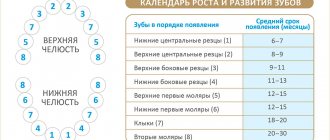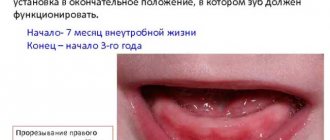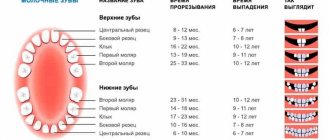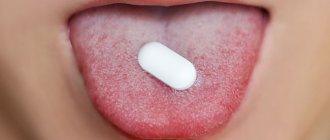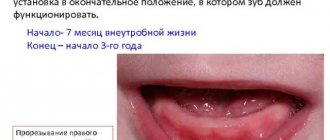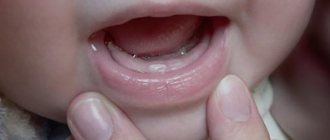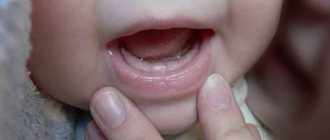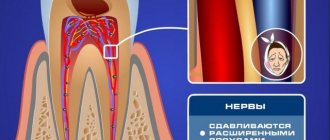The appearance of an infant’s first milk teeth is a difficult period for both him and his parents. The baby often cries, is capricious and demands increased attention from mom and dad. Teething is often accompanied by an increase in temperature. It lasts for 1-3 days, after which the child’s condition stabilizes.
Teething can be called a purely individual process. In some children it is completely asymptomatic, while in others very unpleasant symptoms appear that significantly worsen the baby’s life - diarrhea, hyperthermia, loss of appetite, inflammation of the gums and others. This clinical picture often confuses parents - they cannot understand whether these signs are related to teething or whether the child is developing some kind of pathology.
Parents' biggest concern during teething is temperature. It can rise to dangerous levels - 39-40°C. To alleviate the child’s condition, it is necessary to be able to provide him with first aid, as well as to recognize in time the signs indicating that you urgently need to either call an ambulance or go to the hospital yourself.
When?
Teething for a baby is a rather complicated and not always pleasant process, both for parents and for the baby himself. During this period, the baby experiences a storm of feelings and emotions, often of an unpleasant nature. In most children, the process of erupting the first teeth begins at about 6 months, although physiological deviations are possible either towards an earlier or later appearance of the first tooth.
There are only 20 teeth in a child's primary dentition. Unlike permanent teeth, primary dentition lacks premolars—small molars. The first group of incisors to emerge is the front teeth; there are four of them on each jaw - two central and two lateral. In the period from 6-8 months, the lower central incisors erupt first, followed by the upper central incisors a little later. As can be seen from the description, the baby’s teeth erupt in antagonizing (opposite on the upper and lower jaws) pairs; antagonism implies the teeth coming into contact. This is very important, since gradually, along with the process of teething, the height of the bite is built, and the child is already able to process tougher foods. At the age of 8-12 months, the lateral incisors should begin to emerge, as well as the central incisors, first appearing on the lower jaw, and then the upper. According to the standard scheme, the baby has eight teeth.
After a certain break, a group of fangs erupts; there are two of them on each jaw. At 16-20 months, fangs appear on the lower jaw, and after the eruption of the lower canines, on the upper. Fangs are the most difficult teeth to cut through, this is due to the anatomical features of the tooth itself and its location.
After teething, the child is able to fully bite off hard food, but he still has nothing to chew it with. For this purpose, in the subsequent period, a chewing group of teeth appears - molars or large molars. There are four of them on each jaw - two on the right, two on the left on each jaw. Eruption of molars begins at 20-30 months. After teething in this group, the baby is able to fully chew solid food, since the oral cavity contains all groups of teeth. By the age of 2.5-3 years, all 20 baby teeth should erupt in the child’s mouth.
Violation of deadlines and order
Some children experience either a delay in the appearance of the first tooth or teeth erupting earlier than the average. A delay in teething from the average period of 1.5 - 2 months is a variant of the norm. This can be attributed to factors delaying teething - heredity, nutrition, season of birth - winter and spring babies have teeth earlier. But, if a child has not erupted a single tooth in a year, it is necessary to immediately contact a dentist, pediatrician and endocrinologist. Delay in teething can be an indicator of many endocrinological diseases and metabolic disorders, including rickets.
In the early stages of teething - and there are cases of babies being born with teeth or teething in the first 2-3 months, it is also necessary to conduct research with an endocrinologist.
In teething, not only the timing is important, but also the sequence of teething. These two factors are taken into account during the examination. But, do not forget that there are hereditary factors, and when teething they are very important. How did your parents cut teeth? They will erupt in approximately the same way in children. Many other factors should be taken into account, such as the bad habits of the mother, the diseases she suffered during pregnancy, the due date of the child, and the course of labor. Chronic diseases of mom and dad are taken into account, diseases that the baby suffered in the first months of his life are examined, special attention is paid to ARVI. It is necessary to monitor how the child develops, what kind of feeding he is on, what the dynamics of weight and height are, etc. All these and other factors can, to one degree or another, affect the timing of teething.
Is it possible to walk with a child with a fever?
If the baby’s general condition does not suffer much during teething, and the temperature is not high and is well controlled by antipyretic drugs, then a walk may even be beneficial. The main thing is to dress your child according to the weather, try to stay away from other children (since you can easily catch an infection) and not tire your baby with active outdoor games.
If the fever reaches high levels and the child does not tolerate it well, then it is better to refuse a walk until the condition improves.
In any case, even if parents are sure that the increase in temperature is caused by teething, medical consultation is necessary. You should not self-medicate, since incorrect measures will not only not alleviate the baby’s condition, but can also harm his health.
Signs of teething
And you can learn about this joyful event some time before the tooth itself appears, when harbingers of teething can be noticed in the baby’s behavior. These include moodiness, decreased appetite, sometimes even to the point of refusing to eat, increased fatigue, drowsiness, and even sometimes increased temperature, and some loosening of the stool.
The baby’s whims are associated with a series of unpleasant sensations that constantly accompany the advancement of the tooth in the jaw. A tooth that is trying to erupt seems to tear the gum from the inside. At these moments, the baby is bothered by such sensations as itching, burning, and sometimes pain. To alleviate his condition, the baby “scratches” his gums with various hard objects that come across his path, pulls everything into his mouth, and bites. Under no circumstances should you stop such actions, just replace the unsuitable item with a teether, the direct purpose of which is to help with teething and relieve discomfort.
Because of the same unpleasant sensations, the baby often refuses to eat food, especially hot food, which intensifies the unpleasant sensations. More often, there is simply a decrease in appetite; while eating, the baby is capricious and fidgets. Breastfed babies may cause feeding pain to their mothers as they try to bite their mother's nipple. Before eating, it is recommended to do a light massage of the gums to alleviate the baby’s condition and somewhat simplify the feeding process.
Increased fatigue may be associated with a slight increase in temperature; during teething, the temperature never exceeds 37.5-38 degrees. If the temperature rises higher, then it is necessary to look for another reason, it is definitely not because of the teeth. During this period, it is simply necessary to devote more time to the child, in every possible way distracting him from painful sensations. Parents need to mentally prepare for sleepless nights and constant rocking of the child in their arms.
What temperature is considered normal?
What parameters should you pay attention to? If the birth of the chewing organs is accompanied by a temperature that does not rise above 37.7 degrees, take it calmly. The temperature during the eruption of molars may be lower. It all depends on the complexity of this process. Minor deviations indicate that the units are being cut normally. Although the baby has become more restless, in such a situation this is natural behavior.
Give your body the opportunity to cope with problems on its own. If you intervene in this condition for no reason, the baby’s immunity will not be strengthened. Do not attempt to use medications. They are used when the temperature is high and lasts a long time. To improve your well-being, the following measures are taken:
- A comfortable and calm environment is created.
- Regular ventilation of the room is ensured.
- Providing adequate sleep and rest.
- A balanced diet and drinking regime are being established.
- Ensure heat exchange by removing clothing that restricts movement.
It is not recommended to introduce new dishes into the diet during this period. If a child has a malocclusion, he needs to be seen by a dentist. There is no point in delaying this. The sooner you notice the problem, the faster the treatment will take place and the more effective the result will be.
What is the reason for the increase in temperature during teething?
During eruption, inflammation occurs in the gums, local immunity decreases, and due to this, a slight increase in temperature occurs. Naturally, the body tries to defend itself; the role of a protector is played by saliva, which has many functions, including anti-inflammatory and bactericidal. This is why babies salivate so much when teething.
It is necessary to pay attention not only to the increase in temperature, but also to the child’s stool. When teething, you may experience loose stools (soft paste of the usual color, somewhat more often than usual), but not diarrhea.
Changing teeth to permanent ones
The eruption of permanent teeth also begins with precursors; baby teeth gradually leave the oral cavity, and they are replaced by permanent teeth that will serve the child throughout his life.
The eruption of permanent teeth begins at 6-7 years of age with the appearance of the first permanent molars - large molars; most often eruption begins on the lower jaw, and then on the upper. Then eruption follows the same pattern as during the eruption of baby teeth. The first to change are the front incisors of the lower jaw; this occurs approximately at the same time as the eruption of the first permanent molar. On the upper jaw, the central incisors change from about 7-8 years of age; at the same time as the eruption of this group of teeth, the lateral incisors of the lower jaw erupt. At 8-9 years of age, the lateral incisors of the upper jaw begin to erupt. As can be seen, the principle of pairing is preserved in the eruption of permanent teeth. At 9-10 years old the canine teeth change. And at the same time, in the oral cavity, in place of the primary molars, teeth appear that were not present in the primary occlusion; these are premolars. There are four premolars on each jaw - two on the right, two on the left on each jaw. These teeth belong to the chewing group of teeth and are designed for chewing food. At the age of 10-12 years, the first premolar erupts on the upper jaw, and subsequently all the other premolars. From 11-12 the fangs on the upper jaw change. At approximately the same time, the second molars of the lower and upper jaws erupt; it is not fundamentally important on which jaw the tooth erupted first. At this stage, the alignment of the teeth into dental arches is completed and the formation of the bite height, which is not only aesthetically important, but also important for proper chewing of food.
At this stage, teething is over; only from 17-25 years old can third molars, or so-called wisdom teeth, emerge. Their eruption is conditional, and their complete absence is considered a variant of the norm. In most cases, only a few teeth erupt, but not all four. The difficulty in cutting through them is due to the lack of space in the jaw. Recently, they have been regarded as a rudimentary organ - an organ that has not reached full development and has lost its functional significance in the process of evolution.
So, the process of teething is not so complicated; if you pay close attention to the health of your teeth from the moment they appear, you can keep your baby healthy and a snow-white smile for life.
The author thanks the pediatric dentist Yu. S. Lapushkina for consultations.
Why does a baby's body temperature rise when teething?
Teething is an important stage in the life of every child. Only a small number of children manage to avoid various unpleasant symptoms that accompany the appearance of dental units. Most babies experience pain, bowel movements, swelling of the gums and fever when teething. The temperature during teething rises for the following reasons:
- substances characterized by increased biological activity are released;
- general immunity decreases;
- weakens local immunity in the child’s mouth.
What does Komarovsky say about teething? The opinion of an authoritative doctor is presented in the video accompanying the article. The processes of heat exchange in the body of infants under one year of age are not yet stable enough, so almost any “shock” can provoke a reaction in the form of an increase in temperature. Older children may experience fever when their fangs erupt due to their large size and location.
How long does the temperature last
Gum inflammation in young children is a common dental disease. After all, children's mucous tissues are unprotected and delicate, and local protective forces are not yet fully operational. If the temperature jumps 39-40 degrees, consult a doctor immediately. Sometimes, at the time of the appearance of incisors, canines and molars, high body temperatures can last for several days.
If the high temperature returns to normal within three days, this is normal. But, there is prolonged hyperthermia. In this case, safety will be ensured by a pediatrician. He will be able to determine whether there is another reason for this phenomenon. When teething, the temperature can last a long time and go down badly. Therefore, you should not risk the child’s health; you should call a doctor in time. He will determine whether there is an infection, whether there is persistent swelling with hemorrhage on the gum. Perhaps such a clinical picture develops with the active birth of two masticatory organs at once.
Parental care and love works wonders! Involve your little one in the game more often. Take him in your arms. An upright position will relieve pain as it will reduce blood flow to the gums. Be patient! Do not let your baby scream or cry for a long time, this exhausts his nervous system.
Pain and other associated symptoms
How to understand and determine that babies are teething? Different children experience different symptoms of teething. In rare cases, teeth appear quickly and without deterioration in health. For most babies, the appearance of the first units is accompanied by a whole complex of unpleasant symptoms. In addition to elevated body temperature (not everyone experiences this symptom), accompanying symptoms include:
- redness and swelling of the gums in places where a tooth will soon appear;
- intense salivation (constantly flowing drool irritates the delicate skin around the mouth and chin, so irritation may occur in these areas);
- redness in the baby’s buttocks and cheeks;
- diarrhea;
- constipation (rare);
- refusal to eat;
- sleep disorders;
- the child constantly puts toys, pacifiers, and his own hands into his mouth to scratch the place where the tooth is coming out;
- signs characteristic of some viral infections (runny nose, cough, general weakness).
It is important to be able to distinguish signs of eruption from manifestations of pathological processes in the body. If suspicious symptoms appear, you should immediately consult a doctor to make an accurate diagnosis.
To what values and for how long can the temperature rise?
How long does the temperature last during teething? How intense can the fever be? After how many days is it time to start worrying and call a doctor? These questions concern almost all mothers and fathers during the teething period of the baby. Typically, hyperthermia is observed during the period when the unit breaks through the mucous membrane of the gums, and lasts no more than 3 days.
When changing dentition from milk to molar, strong and prolonged heat is usually not observed. A slight increase in temperature can be observed during the eruption of the largest teeth - canines, molars, and less commonly - premolars.
Subfebrile values mean an increase in body temperature relative to normal by no more than 1.5 degrees. That is, if the thermometer showed a value of up to 38°C, the child’s condition is considered normal and the use of antipyretic drugs is not required. Typically, the temperature remains within normal limits during the day and rises in the evening and at night. If body temperature has reached maximum values (up to 40°C), the use of medications is required.
Symptoms indicating pathology
An increase in temperature during teething is a natural process. This is a kind of protective reaction of the baby’s body. At this time, it is necessary to carefully assess the general condition of the child. Sometimes dangerous pathologies can be hidden behind teething syndrome. Therefore, parents should know the symptoms indicating the progression of the pathological process:
- Vomit. Single vomiting can occur at high temperatures. But if it recurs, the baby feels very bad and has diarrhea, you need to see a doctor as soon as possible. These are signs of intestinal infection or poisoning.
- Nasal congestion or discharge of thick yellow-green snot. This is not the norm, it is a pathology that requires adequate and immediate treatment.
- Coughing. During teething, a lot of saliva is released. Often children simply do not have time to swallow it, and they may choke. A cough appears reflexively, which is not pathological. But if wheezing is heard and a certain amount of sputum is released during coughing, this indicates the development of diseases of the upper respiratory tract (tracheitis, bronchitis and others).
- Stomach ache. With normal teething, this symptom should be absent. If the baby is restless, capricious, cries, or pulls his legs toward his stomach, these are alarming signs. Especially if the abdominal pain is accompanied by repeated vomiting. This symptom complex indicates the development of an intestinal infection. The child could pick it up through toys and other objects that he pulled into his mouth.
- Red throat. Swelling from the gums does not spread to the palate. It can spread to the nasal cavity. If the throat and palate are hyperemic (reddened) upon examination, this is the first sign of the development of pharyngitis.
If you have at least one of these symptoms, you should immediately contact your doctor or go to a medical facility. There the child will be examined by a pediatrician and prescribed the correct treatment. It is prohibited to give any medications (except antipyretics) at home without prior approval from the doctor.

